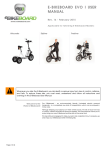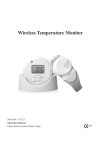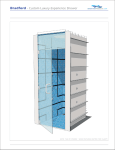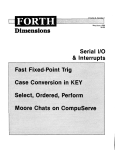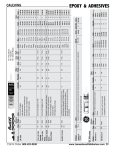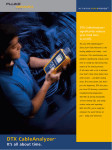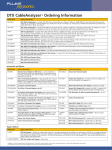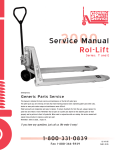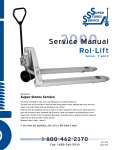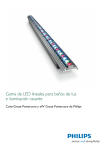Download Industrial LC Plug Termination
Transcript
Industrial LC Plug Termination Instructions A B C D E COMPONENTS: A. LC connectors B. Crimp Rings C. O-ring D. LC Connector Holder E. Industrial Housing Tools Required: F-TERM-L2 FTERM-XLC 2 Slide the Industrial Housing over the fiber jacket. Using the marker pen and the template card provided (included with FTERM-XLC), measure and mark the outer jacket at the “A” length. 3 Using a jacket strip tool, strip the outer jacket at the “A” length indicated on the template card provided (included with FTERMXLC and on last page). 4 Expiration Date mm/dd/yy Remove cap from the LightSpeed® adhesive syringe by unthreading it. Install the metal syringe tip provided by threading it onto cartridge until it locks. 1 Note: Save the syringe cap to re-cap when a partially used syringe is returned to the case for later use. Using the marker pen and the template card provided (included with FTERM-XLC), measure and mark the inner jacket at the “B” length. 5 Place crimp sleeves over jacketed strands, cuff side first Jacket Removal: For Jacketed Terminations: Using the jacket stripper tool, strip off the outer jacket at the “B” length indicated on the template card. Use the 1.0mm opening for 1.6mm fiber. Also trim the Kevlar to the ‘C’ length using the electrician style scissors. 6 Using the marker pen and the template card provided (included with FTERM-XLC and on last page), measure and mark the buffer at the “D” length. 7 8 Using the buffer strippers, strip off the buffer in at least two pieces. Note 1: Attempting to strip the entire length of buffer in one swipe will typically result in breakage. Note 2: Be sure the tool blade area is free of buffer debris. Using a dry, lint-free wipe; Remove any remnants of the protective coating on the fiber after stripping the buffer. 9 Important : Ensure that all remnants of the coating are removed or the fiber will not fit into the connector. DO NOT touch fiber after cleaning. Industrial LC Plug Termination Instructions Minimum usable depth line Insert primer bottle into the stand. Dip the entire exposed fiber into the LightSpeed® primer and place in a protected area. 10 Note: It is important that the entire exposed fiber be coated with the primer including some portion of the buffer material. For jacketed terminations, do not be concerned with keeping the kevlar strands out of the primer solution. Hold the flat surface of the scribe tool flat against the ferrule tip with the beveled edge facing up. Carefully score the fiber close to the intersection of the ferrule tip and fiber. Score on one side only. Clean the adhesive off blade. 14 Note: Do not use excessive pressure to prevent fiber breakage and uneven fractures. If breakage occurs see note 2 in next step. Expiration Date mm/dd/yy Important!! To avoid possible fiber breakage, do not insert the fiber so far that it contacts the bottom of the primer bottle!! The primer bottle label indicates the minimum usable depth. 11 Note: Cap the bottle when not in use to avoid contamination. Store both primer and adhesive between 40° F (4.4° C) and 100° F (38° C). Remove the excess fiber with a straight, non-twisting pull and deposit in a safe place (i.e. onto a piece of tape or in the debris container). 15 Remove dust cap from the connector and insert the adhesive syringe tip into connector housing until it seats firmly inside. Inject the LightSpeed adhesive until a small dot of the adhesive appears at the ferrule tip. Also inject a small amount of adhesive into the back end of the connector. This ensures bonding of the buffer to the connector, strengthening the termination. Be careful not to overfill to prevent a backflow of adhesive. 12 16 Slide the crimp sleeve over the kevlar to the base of the connector. Insert the fiber into the connector until the buffer bottoms out inside the housing. Allow at least 30 seconds cure time before proceeding. Tip: Rotate the connector during insertion to assist in guiding the fiber into the ferrule. 13 Using the 0.137 marked opening in the crimp tool, crimp the sleeve over the Kevlar and knurl bushing as shown. 17 Note1: If fiber does not readily pull off, repeat previous step – scoring on opposite side of fiber. Note 2: Fiber pieces are difficult to see. If not properly disposed, glass fibers may cause serious injury. Note 3: Be careful not to bump or brush end-face before polishing. FIBER (A) Strain relief cuff FIBER (B) Insert the LC connectors in the LC connector holder as shown. Ensure that the latches are defeated and placed under the latch lip securely. The alignment grove on the back end of the LC connector should “snap” into the internal protrusions of the LC connector holder. When assembled, both connectors should be seated at identical height. 18a Note: To ensure proper transmitter-toreceiver patching, be certain to assemble each end of a duplex assembly with the opposing orientation as shown. To help identify proper orientation it is helpful to place the same color shrink tubing on opposite end of the same fiber strand. If correctly assembled, the final duplex assembly will have opposite color-coded strands on the A side as well as the B side. 18b Slowly pull the cable slack from the back of the Industrial housing while aligning the LC connector holder for proper placement in the housing. 19 Tighten the cable strain relief cuff to a max. of 10 inch lbs. (Hand tighten) Ensure gland seal is on outer jacket. #1 Film (Gray): Perform an “air polish” by holding the connector in one hand and the #1 polishing film in the other. Gently brush the dull side of the polishing film in a “figure 8” fashion against the ferrule tip to wear the small fiber protrusion into a smoother, more polishable tip. Continue until the tip is almost flush with the ferrule. 20 Industrial LC Plug Termination Instructions #2 Film (Pink): Place the polishing pad onto a flat surface with the rubber side facing up. Place the #2 film onto the polishing pad with the glossy side of film down. 21 Note: Prior to polishing, clean pad surface with alcohol soaked wipe to provide for a smooth polishing surface. This will also allow the polishing paper to stick in place. (Ensure no air is trapped between pad and film). Also clean polishing puck. Add a minimum of 3 or 4 drops of distilled/deionized water on the polishing film . Carefully insert the connector ferrule into the XLC duplex polishing puck and gently place it on the pad. Avoid bumping ferrule tip on puck or crushing exposed fiber onto the pad. 22 Gently grip the connector and apply medium pressure and polish in a 50-75mm (2-3 in.) “figure 8” pattern for 25 to 30 revolutions. 23 24 Remove puck from film and blot on a clean wipe. Important: Do not over-polish and do not use excessive pressure. See Step 22a for efficient use of polishing film. 4-STEP POLISH QUICK REFERENCE GUIDE Film #1 (12 mic. Air-polish): Film Color = Gray Pressure = Light Cycles = Conditional Film #2 (3 mic. Wet Pad-polish): Film Color = Pink Pressure = Medium Cycles = 25 to 30 #3 Film (Purple): Replace the #2 film with the purple #3 film and repeat steps 20-21. 25 25a Film #3 (1 mic. Wet Pad-polish): Film Color = Purple Pressure = Medium Cycles = 30 to 35 Note: To optimize optical performance of the connectors while maximizing polishing film life, use separate sections of the film per 14 connectors. Using five sections of the film assures a life of at least 70 connectors per film. Variables such as amount of adhesive on tip, size of “figure 8”, and polishing pressure can also affect film life. #4 Finishing Film (White): Required for singlemode and recommended for multimode especially 50/125 micron laser optimized applications. Replace the #3 film with the white #4 film and repeat steps 19-21 but use light pressure for 25 to 35 cycles. 27 *Use step 25 in place of 22a. See 25 before proceeding. #4 Finishing Film (White). Use one section of the film per connectors. Be sure to limit the size of the “Figure 8’s” to 1.5 inches in height. The same section of this film is not reusable as with the #2 & 3 films. 28 IMPORTANT: Remove the connector from the polishing puck and clean the ferrule and puck using a lint-free wipe moistened with 99% reagent grade isopropyl alcohol or alcohol-soaked pads. It is also important to thoroughly rinse surface of film with distilled/ deionized water prior to storing to assure ideal conditions for next connector. 26 Applicable to films 2 & 3 only. Film #4 (Finish Film Wet Pad-polish): Film Color = White Pressure = Light Cycles = 20 to 30 29 Prior to viewing endface of connector with microscope, clean with a dry lint-free wipe. Using the microscope fitted with the XLC compatible insert*, inspect the polished surface for scratches, voids or chips. If polish is acceptable, place dust cap on connector. 30 Note: It is also recommended to check insertion loss and/or back reflection with a power meter and light source. XLC compatible insert can easily be installed by unscrewing existing insert and replacing with XLC insert.. -See XLC upgrade kit for insert. Industrial LC Plug Termination Instructions Multimode GOOD POLISH (XGLO) Singlemode GOOD POLISH (LightSystem & XGLO) FRACTURE NOT ACCEPTABLE Replace dust caps onto the connector ferrules while connectors are not in use. 32 Place the optional dust cap (XP-MCAP) chain over plug housing and position between compression nut and plug assembly as shown. Tighten chain to secure. 33 Please Note: The LC dust caps must be removed to use the XP-MCAP. Place the O-ring over the LC connector holder as shown. (Use recovery polish) Rev. B 07/07 100.12954 (LightSystem only) (Light scratches, dark ring is caused by adhesive) Recovery Polish (if required) Scratch Recovery: Repeat steps 22-24 (#3 film and #4 film). Fracture Recovery: This procedure requires the 6 micron recovery film (P/N: FT-PF6) sold separately. Using the 6 micron recovery film, repeat steps 19-21 using medium to hard pressure then start over from step 18 with #2 film. 31 To assist safe installations, comply with the following: A. Use caution when installing or modifying telecommunications circuits. B. Never touch uninsulated wire terminals unless the circuit has been disconnected. C. Never install this device in a wet location. D. Never install wiring during a lightning storm. Global Headquarters Watertown, Connecticut USA Tel: (1) 866-548-5814 For a complete listing of our global offices visit our web site www.siemon.com © 2007 Siemon Multimode ACCEPTABLE POLISH




